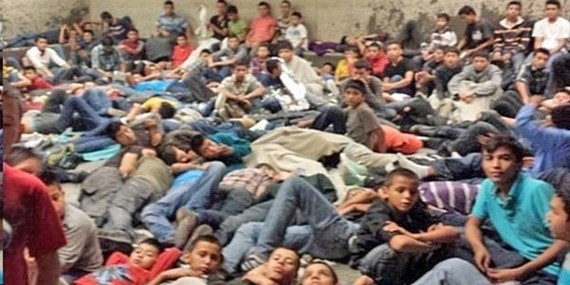The frontier between Texas and Mexico has defied a cultural and economic simplicity since long before General John "Black Jack" Pershing wasted almost two years fruitlessly chasing Pancho Villa through the high deserts of Mexico and the American Southwest. Very little is what it appears to be in such a landscape. Villa was a hero and villain on both sides of the Rio Grande, and his character, ultimately, could only be contained by an historical mythology. A century later, logic and clarity about the border are still as evasive as Villa.
A watershed of about 336,000 square miles in two countries drains into the Rio Grande as it carves deep canyons like Boquillas and Santa Elena on its more than 1000 mile trip along the Texas border to the Gulf of Mexico. By the time its waters are gathered up behind two great dams at lakes Amistad and Falcon, the river is timid as it finally enters the 120-mile stretch of a sub-tropical flood plain, which is the only reach of the long basin that is referred to as the "Rio Grande Valley."
Texas state government, businesses, and entrepreneurs have historically ignored or shorted the region when allocating tax dollars and resources. Poverty was persistent. Educational opportunities were limited. Even in 2014, candidates for public office have referred to the Rio Grande Valley as a "third world" or a "war zone" because of border crossers doing human and drug trafficking, feeding the American appetite for narcotics. And politicians are now treating the valley as a battlefield where the debate is joined over immigration.
They are missing one of the more promising of contemporary American stories.
While the governor of Texas skims the Rio Grande in a gunboat with four machine guns and a talk show host onboard, and the president keeps a measured distance, the residents of the Rio Grande Valley are helping the children arriving in a strange land. Every night, volunteers travel to churches in McAllen, Brownsville, and Harlingen to provide food, clothing, and shelter to the children that have crossed the river. They are filling pantries and donating whatever is needed without asking the government for assistance, and working long hours to assist.
"We don't control the federal law," said McAllen Mayor Jim Darling. "We are only doing what we can do. And that's help people who are in our community and need help. That's who we are. Just in our county, our taxpayers have spent about $70,000 dollars, and we'll ask the federal government to reimburse us, but we aren't going to stop helping, if they don't."
Residents of the Rio Grande Valley are sensitive to deprivations. Before the state decided to act, landowners down here were able to offer the poor small plots of unimproved land to construct modest houses. There were no regulations. Law required no utilities. Colonias, unincorporated and unregulated neighborhoods, rose up without sewers and unpaved streets, lacked electricity and generated disease. People suffered. Many still struggle on the edge of a rising economy.
Prosperity's historic slow expansion in the Rio Grande Valley has been largely a product of being geographically and politically marginalized. The flawed perception is repeating itself with the influx of unaccompanied minors and families from Central America; political voices are treating the valley as hardly more than a setting for talk shows and shouting matches about American sovereignty.
But they might be witlessly standing in the midst of the country's future-scape.
Even if the government can't figure out the border, people of the Rio Grande Valley already know how to conduct commerce and international relations. Every day about 2000 executives from Texas commute across the river into Reynosa to manage manufacturing facilities used by global corporations operating in Mexico and selling to U.S. markets under free trade agreements. The governor's manly exhortations about the dangers of the border were almost irresponsible with a half dozen South Korean companies touring the McAllen area to consider locating their firms in the city. Two hundred Japanese businesses were in the city a few days previously for an assessment as the political rhetoric wheeled and turned without purpose.
"People who live here know what things are really like," said Keith Patridge, CEO of the McAllen Economic Development Corporation. "But every time we get an international company visiting, they ask those questions. But then we take them around and they see things aren't like what they've seen on TV or read about on the Internet and they usually end up bringing their businesses here."
McAllen, just a few miles from the border, added 5000 new jobs in the past year, and was named by a national business data group as the best place in the U.S. to be a solo entrepreneur. Harlingen, in the middle of the Rio Grande Valley, was picked as the most affordable city in the U.S. for raising a family, and the National Civic League recently selected Brownsville as an All American City. A federal clearance has also just been granted for Brownsville and Elon Musk to seek a permit for his Space X launch facility to be built at nearby Boca Chica Beach on the Gulf of Mexico.
"So, we're really excited about having our area being put on the map in such a positive way," said Deborah Portillo, a Brownsville commissioner. "But not only that, having something to counter all that negative criticism that has been put out there. You know if you really and truly think about it, a company like Space X wouldn't come to a community that has been painted so horribly. That should give the general public pause, and they should ask would a billion dollar company really invest so much money to go into an area that is so dangerous? I don't think so."
Because of its adjacency to Mexico, the Rio Grande Valley gets bad publicity associated with drug cartel violence. According to federal crime statistics, however, the valley communities are among the safest of their size in the U.S. The geography of the region is also about to deliver an economic bonanza that will likely overwhelm negative perceptions. The RGV sits in the middle of two of the largest oil shale fields in North America: the Eagle Ford in Southwest Texas and the emerging Burgos Basin in Northern Mexico. Gas pipelines are being built to deliver energy to power plants south of the border and the Port of Brownsville for export. Five different companies have options to build gas liquefaction plants at the port. Just one of those projects will create 3000 construction jobs.
South of the River, the Mexicans have completed their first superhighway from the Pacific Coast to the Gulf, which reduces shipping distances to the Midwest and Northeastern U.S. markets by more than a thousand miles. The twelve bridges across the river in the Rio Grande Valley are about to become the busiest land ports in North America.
"I think we are sitting in a really good place," said Eduardo Campirano, Director of the Port of Brownsville. "For the first time we may be at the right place at the right time and I don't mean just the port but the region as a whole to be able to support that cheap gas brings industry to the region. I believe we are going to see the next industrial renaissance occur in this area. There's just so many pluses that people don't realize this is going to be the face of America in 35, 40, 50 years, so you might as well get used to it."
The forty communities of the RGV are overwhelmingly Hispanic and demographic growth charts indicate the rest of the state will also be a majority minority, possibly in less than a decade. The transition and the increasing importance of that population group has not gone unnoticed by visionaries. The University of Texas has committed $700 million dollars to the region by merging the historic campuses of UT Pan American and UT Brownsville. The resultant institution, which will include a new $54 million dollar medical school, is expected to create one of the largest education complexes in the nation when the first class enrolls in 2015.
There are already tens of thousands of students being served by the multiple campuses of South Texas College, Texas Southmost, and Texas State Technical College. In fact, the North American Advanced Manufacturing Research and Education Initiative at South Texas College developed the process of rapid response manufacturing. The technology and protocols enable a company to create products after they are sold, and avoid the costs of inventory storage while experiencing the market advantage of simplified resource planning. Global brand manufacturing facilities just south of the Rio Grande use rapid response daily to get products created and immediately into the international marketplace.
Those of us who have lived and worked on the Texas-Mexico border find ourselves resenting the political oversimplifications of the immigration challenge. The border can be secured. Guns can be emplaced the entire length and every time children hold hands and try to cross the water we can fire warning shots at their feet. We can also string concertina wire all the way from Brownsville to San Diego and have multiple "Checkpoint Charlies," emulating the Berlin Wall. Boots and guns on the ground, though, are not likely to completely stop desperate people on the move. Reinforcing the frontier with personnel and equipment ignores the nuance of the fact that families have lived and worked on both sides of the river for centuries. They share a culture and a history that laws have trouble defining and dividing. America needs to protect its laws and borders while also understanding relationships that predate the current political climate. We also need to accept our responsibility for a significant role in creating a world that drove those children to risk crossing Mexico to reach our country.
No one down here is suggesting an open border. U.S. foreign policy and economic aid to Central American countries, perhaps, instead of pumping billions into Mideast imbroglios, is likely to ease the flow of refugees toward Texas. But no answer is workable until politicians in Washington and Austin realize the Rio Grande Valley is not a battlefield.
It's probably a first glimpse at the future.
Also at: Texas to the World

